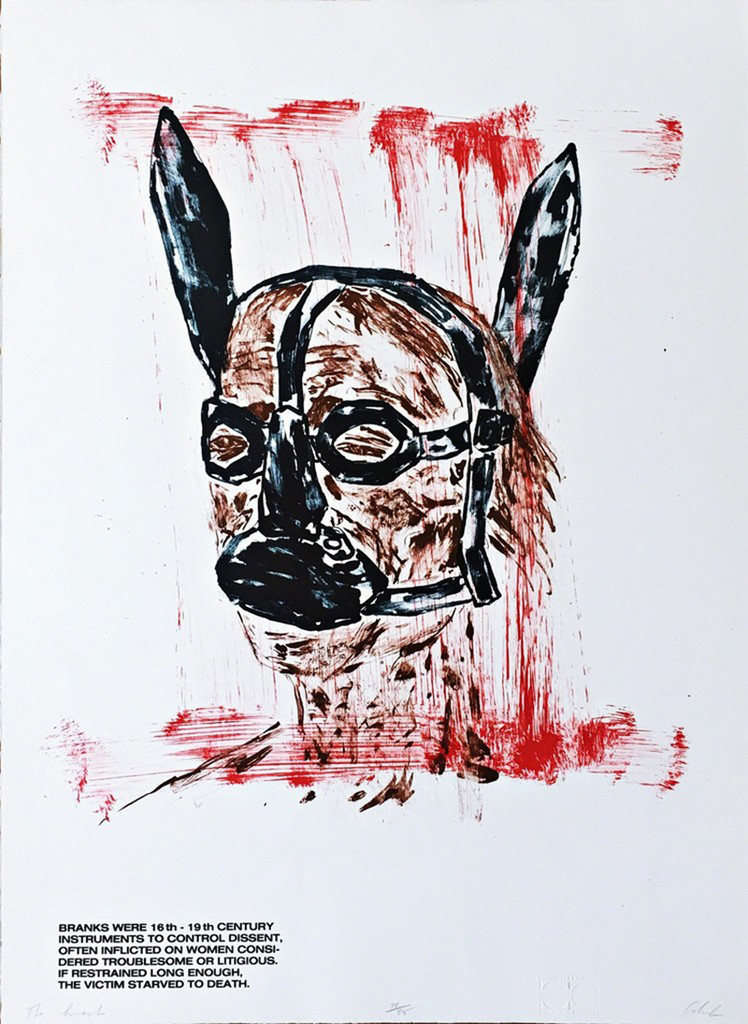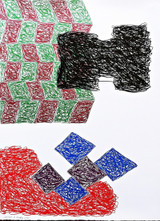
An Educated Collector is Our Best Client
In business for nearly two decades, we are a well established, popular contemporary art boutique specializing in expertly chosen, blue chip prints, multiples, uniques, books, ephemera and merchandise at different price points, with a focus on the secondary market. Please click on the "Contact Us" button at the bottom of this page for questions about any work, pricing and/or to arrange to visit our showroom/gallery - located in between Manhattan's Flatiron and Chelsea Flower Districts.
Leon Golub The Brank 1985, Flatbed Offset Lithograph on Arches Paper with Deckled Edges. Publisher's and Printer's Blind Stamps. Hand Signed. Numbered. Unframed.
CONTACT GALLERY FOR PRICE
Description
This lithographic print by Leon Golub is titled," The Branks". A branks - also known as a scold's bridle, a witch's bridle, or a brank's bridle - was an instrument of punishment, as a form of torture and public humiliation. The device was an iron muzzle in an iron framework that enclosed the head (although some bridles were masks that depicted suffering.). This is a quintessential Leon Golub work reflecting the artist's preoccupation with torture, with muzzle engulfed in a blood-red border: explicit, ironic, macabre, anguished unsparing. In a 2018 review in "The Brooklyn Rail" of an exhibition featuring this work, Mary Ann Caws writes, "... I couldn’t bear the black leather “witch’s bridle” of The Brank (1984) with its donkey ears—sending me back to that excruciating 1944 Salvador Dali novel called Hidden Faces with its ghastly witnessing of an epoch...."
The text on the lower left quadrant of the print reads as follows:
Branks were 16th - 19th century instruments to control dissent, often inflicted on women considered troublesome or litigious. If restrained long enough, the victim starved to death.
Leon Golub started making art in the late 1940s, after serving in World War II as an army cartographer. Early in his career, Golub turned away from dominant abstract modes of painting, pervasive in the decades following the war, to create expressive figurative works that confront the dynamics of global power and its victims. His paintings consider the violence and torture in the shadows of governments (especially the U.S. government), out of view of the public and outside of the law. Golub’s method of painting, applying layers of oil and then scraping the surface with a meat cleaver, adds a traumatic and distressed presence to his works, augmenting the horrific acts depicted in the paintings.
As a leader of Chicago’s figurative movement in the 1950s, Leon Golub has always rejected a detached, distanced approach to art, instead espousing expression and confrontation. Described as an existential and activist painter, Golub gained recognition for his large-scale, politically charged, highly topical works that directly address issues of war, racism, sexism, and power.
For Golub abuse of power is both an ancient and a contemporary condition, always present in the world, and the ability of such power to corrupt those who hold it chips away at humanity. Both the victims and the orchestrators of torture and suffering reside outside of ethical boundaries, in a place where social contracts of dignity lie in ruin. Golub portrays a horrible world of degradation, where humans have more in common with objects than subjects, where the right to freedom is flagrantly abandoned.
SIGNATURE
Hand signed, titled and numbered on the lower recto (front) with publisher's and printer's blind stamps.
PROVENANCE
Original Atelier International Portfolio, #78










